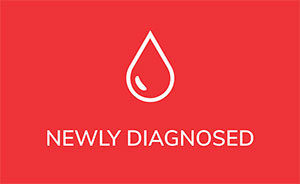
By Manali Kamdar, MD
The presentation and course of CLL is strikingly varied in patients, with some individuals presenting with a biologically indolent course whereas others present with an aggressive course. Hence, it is imperative to get information about individual patient prognosis in order to define a therapeutic strategy and to allow patients to plan their lives moving forward. It is important to understand that these prognostic factors were developed and studied in the era of chemoimmunotherapy. Novel targeted inhibitors, such as ibrutinib and venetoclax, have improved the overall outcomes and landscape in CLL, although the follow-up is limited. Hence, our understanding of prognostic factors in the era of novel inhibitors is still evolving.
Fluorescence in situ hybridization (FISH) based prognostic factors
The four most common chromosomal aberrations that are detected using “FISH” studies at diagnosis are:
1) Deletions on the long arm of chromosome 13 (del (13q14)) (present in 55%)
2) Deletions on the long arm of chromosome 11 (del (11q23)) (present in 18%)
3) Trisomy 12 (present in 16%)
4) Deletions on the short arm of chromosome 17 (del(17p)) (present in 7% at diagnosis)
~Del(13q) is one of the most common chromosomal abnormalities in CLL. Patients presenting with del13 abnormality as a sole chromosomal aberration usually have indolent biology, presentation and a long median survival.
~Del (11q) is a high-risk chromosomal aberration; its incidence increases over time, thus highlighting the need to test for it at diagnosis, as well as at clinical progression. Usually del11q is generally seen in young male patients and tends to present with bulky lymph nodes. It is associated with rapid disease progression and a shorter progression free survival. Some studies have shown that combination chemoimmunotherapy, containing alkylating agents may overcome the negative prognostic implications of del11q. Interestingly recent follow-up data with new drugs, like ibrutinib, showed durable responses in treatment-naïve and relapsed-refractory patients with del11q abnormality. More importantly pooled data from three randomized phase 3 studies showed that del11q was not a prognostic factor for adverse outcomes for patients with CLL.
~Trisomy 12 is considered an “intermediate” risk chromosomal aberration and its impact on therapeutic choices is presently unknown.
~Del (17p) which results in the loss of TP53, is the most important prognostic marker in CLL and is associated with poor outcomes, rapid disease progression and is historically associated with resistance to standard fludarabine-based chemoimmunotherapy. This chromosomal aberration is rare at diagnosis (less than 10%) but is more common in previously-treated patients. This underscores the importance of retesting for this aberration at clinical progression since it has therapeutic implications. 80% of patients with Del (17p) harbor mutations of the remaining TP53 allele. However, 4-5% of CLL patients carry a TP53 mutation in the absence of del (17p). These patients also carry a poor prognosis akin to patients with del (17p). This iterates to the fact that patients should undergo testing for TP53 mutation in addition to standard FISH testing for Del(17p). Patients with del(17p) or TP53 mutation respond well to targeted inhibitors of the B-cell receptor pathway and BCL-2 pathway, such as Ibrutinib and venetoclax respectively. Hence patients with these aberrations at diagnosis or progression are treated with these targeted inhibitors.
Immunoglobulin heavy-chain variable region gene (IGHV) mutational status
IGHV mutational status impacts prognosis based on whether a patient has unmutated (defined as >98% homology with germline gene sequence) versus mutated IGHV. Unmutated IGHV portends a poor survival and shorter treatment-free interval. If patients with mutated IGHV have the presence of VH3-21 usage, their prognosis is inferior to mutated IGHV without VH3-21. IGHV mutation testing is important due to its implications, not only on prognosis but also on choice of therapy. First-line chemoimmunotherapy with FCR has induced long-term remissions and improvement in overall survival in fit patients with CLL with mutated IGHV. On the other hand, unmutated IGHV was no longer shown to be an adverse predictor of outcome in patients treated with Ibrutinib-based therapy.
Flow cytometry or immunohistochemistry (IHC)- based prognostic factors
CD38, CD49d and Zap-70 are flow cytometry-based markers, however CD49d is more important than the other two, since it has an impact on prognosis independent of FISH tests or IGHV mutation status. Most studies have shown that CD38 and Zap-70 correlate well with unmutated IGHV and could be utilized as surrogates. However, reproducibility and standardization of these markers in various laboratories across the country have led to their tempered utility.
Lab based prognostic markers
- High levels of serum beta-2 microglobulin (B2M) (>3.5 mg/l) is associated with shorter response to treatment and overall survival. Patients with renal dysfunction can have falsely elevated levels and hence, caution must be interpreted in this particular situation. Beta-2 microglobulin is also important to calculate the CLL-IPI score for patients which has prognostic implications and will be discussed in the latter part of this review.
- Patients whose absolute lymphocyte count (ALC) takes more than 12 months to double have a better prognosis than those whose lymphocyte count takes less than 12 months to double. Experts suggest that a lymphocyte doubling time of less than 6 months may be a measure to define initiation of therapy.
Recently identified prognostic factors
Amongst the new markers, NOTCH1, SF3B1and BIRC3 mutations are present in low frequency (around 4-15%) in newly-diagnosed CLL, however the incidence increases to nearly 25% in patients refractory to chemotherapy, especially fludarabine. Their prognostic significance is presently unclear since some studies have attributed these mutations to poor outcomes, whereas others have not. Interestingly NOTCH1 mutation was independently associated with Richter’s transformation (conversion of CLL to an aggressive lymphoma). These mutations do not impact choice of therapy at this time.
CLL International Prognostic Index (CLL-IPI)
Due to recent exponential progress in therapeutic options and identification of novel prognostic markers in CLL, the existing clinical staging systems (i.e Rai and Binet staging) have not been able to accurately identify prognostic subgroups. CLL-IPI is an index that was designed to integrate existing clinical staging systems with biological and genetic information to refine and provide more specific information on prognosis. Some experts have also proposed it to be a tool that could assist in decision to initiate therapy.
CLL-IPI
|
Variable |
Adverse Factor |
Grading |
|
TP53(17p) |
Del and/or mutated |
4 |
|
IGHV status |
unmutated |
2 |
|
Beta-2 microglobulin |
>3.5 |
2 |
|
Clinical stage |
Binet B/C or Rai I-IV |
1 |
|
Age |
>65 years |
1 |
|
Risk Group |
Score |
Potential treatment recommendation |
5-yr Overall survival |
|
Low |
0-1 |
Do not treat |
93% |
|
Intermediate |
2-3 |
Do not treat unless symptomatic |
79% |
|
High |
4-6 |
Treatment indicated unless asymptomatic |
63% |
|
Very High |
7-10 |
Treat on clinical trial or novel targeted inhibitor. Do not use chemotherapy |
23% |
In summary, the landscape of CLL therapeutics has changed drastically over the last few years. A huge reason for this is the identification of prognostic factors which throw more light into the heterogeneous biology of the disease. As a result, clinical trials are now being designed to test therapies in various subgroups of patients to predict disease progression, improve response and prolong patient survival.
Dr. Manali Kamdar is the Clinical Director of Lymphoma Services and Assistant Professor of Medicine at the University of Colorado School of Medicine
Originally published in The CLL Tribune Q3 2017.

















